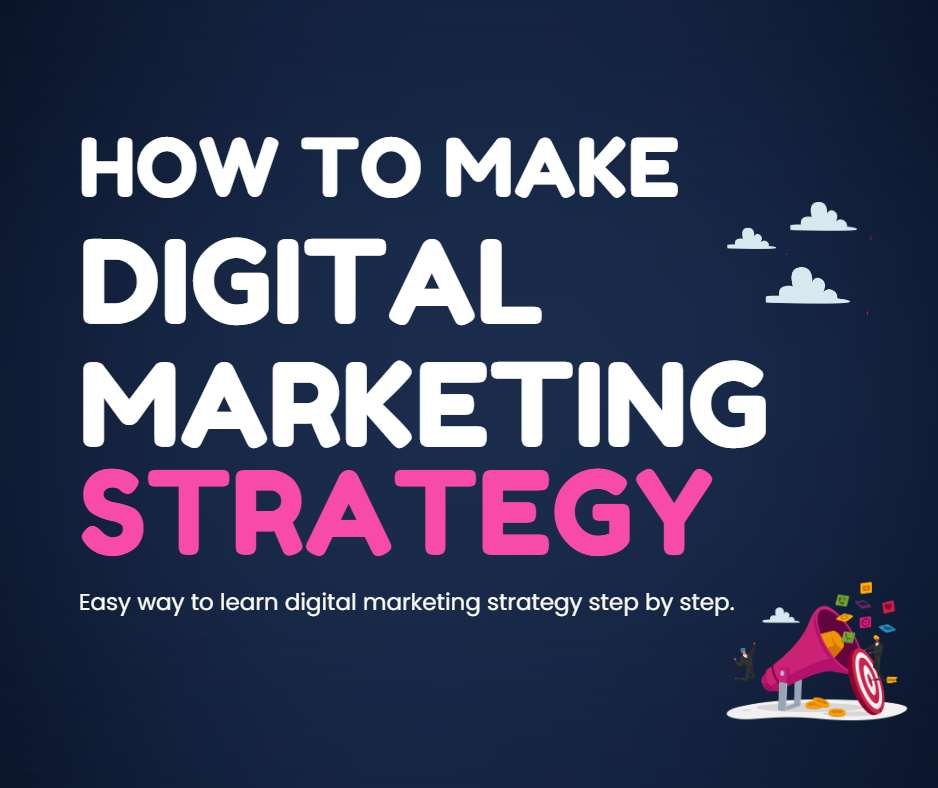You might have heard about digital marketing Strategy, but what is digital marketing Strategy? well, it’s let me give you a simple explanation to get a little bit of knowledge and then we can move on and go deep down to it.
A digital marketing strategy is just a plan that helps your organization or company to reach goals by selected marketing channels like paid, earned, organic search, and social media. ( don’t worry I am gonna explain all of them so you will learn each step.)
The digital marketing strategy aims to increase awareness about the business and bring new customers to your website and brand.
A good digital marketing strategy will help you to reach your goal. but remember a digital marketing strategy always comes with a good “digital marketing campaign” what is the difference between a digital marketing strategy and a digital marketing campaign? Well, it’s simple, digital marketing campaigns are built to blocks and actions, but a digital marketing strategy moves you toward a specific end goal.
How to make a Digital Marketing Strategy?
To make it easier to learn about how to create good digital marketing, I break it into 6 steps:
- Set up Your Goal
- Build Your Buyer Personas
- Understand Marketing Channel & Tools you need
- Evaluate Your Digital Marketing Presence
- Build Your Content Strategy
- Analyze and adjust.
1. Set Up your Goal
The first step is to ask yourself what you hope to achieve with your digital marketing strategy. Don’t pass this question simply. Answer this question with exact details and a specific set of goals. In other words, to determine what you want to accomplish in digital marketing.
Any goals you set have to be measurable and well-defined. By step in a digital marketing campaign, you can measure from start to finish, and you need to take advantage of this from a digital plan with specific milestones and targets.
What are specific goals? Here are some examples:
- Raise brand awareness.
- Make more sales.
- Increase organic traffic.
- Get more subscribers (Email, Website, channel).
- Reduce the cost of PPC (SMM) campaigns.
The above is a good starting point example, but you can decide on your goals. Always start by specifying your goals in business terms and then translating that to digital marketing goals.
2. Build Your Buyer Personas
First thing first, who is your audience (customers)? Before anything, you must know who you want to target. Just stop making a digital marketing strategy without having goals; you can only hope to succeed with a good strategy.
The key reason why digital Marketing is essential is that it allows you to target a specific audience with great precision.
Targeting your audience is defined by specific data. Some examples can be:
- Age.
- Education.
- Gender.
- Location.
- Income power.
- Audience interests.
- And other things.
Your ad budget will be spent more efficiently on your target by targeting demographics. Your goal in making a digital marketing plan is to get inside your target audience and see things from their perspectives.
You can represent your audience by creating a survey, interview, or some research. By collecting this information, you can get more knowledge about your customers.
That might be a question of how to start a persona. Well, to answer this question, there are so many websites you can start to make your personal or business personas to learn or how to target your audience, but my favorite website is creately.com
It’s because you can start for free and a friendly upgrade price. When you click on the link, you will learn more about your audience and target them.
3. Understand Marketing Channel & Tools you need
There are many digital market types for different proposals. Even the most prominent companies don’t do all of them. It is best to choose a few strategies, focus on them, and see their results. Of course, if any strategy doesn’t work, you can change your plan.
Here is the most popular digital marketing you might want to choose:
- Social Media Marketing (SMM)
- Search Engine Optimization (SEO)
- Search Engine Marketing (SEM)
- Content Marketing
- Email Marketing
- Website Marketing
- Video Marketing
Your marketing goals should always be tied back to the fundamental goals of your business. You need to make the most of the effective channels (depending on your business needs) that can help your business grow. Each social media has its own social tools.
They can be helpful for different marketing strategies but not all business strategies. Like social media platforms, there are so many tools on the internet, and again, it depends on the business; you need to choose which one works for you.
Examples include analytics, ad controls, social platform controls, keyword research, and more (I know it’s confusing but don’t worry, I am helping you). Social tools and web tools are essential. They give you valuable data so you can use them to learn more about your audience.
Google Analytics is one of the most popular tools to track and measure your targets, but for most businesses that want to go deeper and get more details about their audience, it can’t help them. That’s why many analytics tools can help more and more precisely. Some companies I can recommend, like HubSpot, are one of the most incredible tools besides Google Analytics. It can help any business grow faster and faster.
4. Evaluate Your Existing Digital Marketing Presence
When you review your existing digital marketing channels and assets to determine what to incorporate into your strategy, it’s helpful to consider the big picture. Why? Because it helps to understand what is coming and stop being confused.
You need to gather what you have so you can measure and have a clear picture of your existing owned media, paid media, and earned media. You can do that through these three types of media. Once you have a list of everything, you can determine which marketing campaigns their assets will best assist you. This is also an excellent time to identify gaps in your asset catalog.
If there’s something that you think would help put your content strategy over the top that you don’t have yet, it’s time to create that content.
5. Create Your Content Strategy
You may have heard it before about the phrase “content is king,” and it’s true for all digital marketing strategies. You must gather everything and create a specific marketing strategy for each channel. Your content strategy may include blogs, eBooks, podcasts, videos, images, and more. Create your content goals and determine which types of content can help you achieve those goals.
Example: If you want to improve your ranking in search results, you need to work on your SEO (Search Engine Optimize) & keyword strategy.
How to find out what types of content can help you?
Get to the point: Focus on the important part of the points and make sure your content is valuable to your audience.
Use value proposition: A value proposition tells your potential audience what they can expect from your brand.
Brand’s Personality: What does brand personality mean? Ensure that every piece of content you create genuinely reflects your brand. That means ensuring your brand is consistent across all channels, the tone of voice, and other traits.
6. Analyze and Monitor your content.
A digital marketing analysis evaluates your business, audience, and competitors to build your company’s custom, data-driven digital marketing plan. Using online marketing analysis, your company can deliver an internet marketing strategy that reaches more audiences and covers them.
Digital marketing analysis will include the following steps: (In most cases)
- Review your business’s current marketing strategy, goals, and audience personas.
- Investigate your competitors’ marketing strategy and target audience.
- Research your target audience’s online behavior, interests, and language.
- Remaking your digital marketing strategy based on your data from the audience.
But this is the most popular for some businesses; it depends on your needs. A professional analysis can give your business a helpful second opinion, resulting in a more robust strategy that generates leads and revenue for your business.
Keeping your eye on engagement, conversions, and traffic figures will give you valuable insights into refining your content strategy. This, in turn, will enable you to create more successful content in the future.




This is my first time pay a quick visit at here and i am really happy to read everthing at one place
Shall we exchange links? My website https://zetds.seychellesyoga.com/jml
Content for your website https://zetds.seychellesyoga.com/info
Web Development Wizards https://zetds.seychellesyoga.com/info
Can provide a link mass to your website https://zetds.seychellesyoga.com/info
Your site’s position in the search results https://zetds.seychellesyoga.com/info
Free analysis of your website https://zetds.seychellesyoga.com/info
Content for your website https://zetds.seychellesyoga.com/info
Web Development Wizards https://zetds.seychellesyoga.com/info
There is definately a lot to find out about this subject. I like all the points you made
you have a great blog here! would you like to make some invite posts on my blog?
Beyond legal ramifications, using a purchased account undermines the integrity of your business and could damage relationships with customers and partners.
Your blog is a constant source of inspiration for me. Your passion for your subject matter shines through in every post, and it’s clear that you genuinely care about making a positive impact on your readers.
NY weekly This is really interesting, You’re a very skilled blogger. I’ve joined your feed and look forward to seeking more of your magnificent post. Also, I’ve shared your site in my social networks!